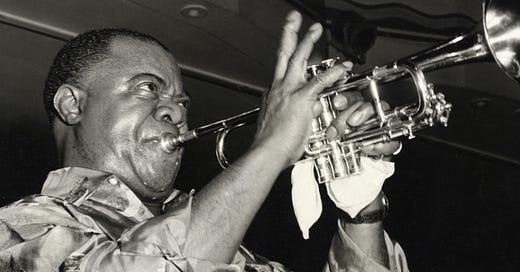Heartland: Louis Armstrong's Black & Blues
A mesmerizing documentary that takes us behind the iconography of the jazzman and shows us, in his own words, the vibrant human soul who lived there.
For Heartland Film Festival showtimes and tickets, click here.
“My only sin, is in my skin…”
Louis Armstrong is undeniably one of America’s most enduring cultural icons. The only trouble with being an icon is that the real, living person tends to recede behind their iconography.
For Louis it was that fantastically gravelly voice, the trumpet he blew like an extension of his very soul, the round face that always seemed split wide open with a smile so wide, as if he could not keep all the joy inside.
“Louis Armstrong’s Black & Blues,” the new documentary directed by Sacha Jenkins that opened this year’s Heartland International Film Festival, is the ultimate look behind the curtain. Instead of, like Oz, behind disappointed by the very human figure behind it we come away even more appreciative of Armstrong’s important place in the American tapestry.
Beyond the usual biographical insight we might expect from a feature-length documentary, “Black & Blues” reveals an important discovery: Armstrong was perhaps his own most diligent chronicler. He spent years clipping his newspaper articles, writing reflections and essays, and making audio recordings of his thoughts, hopes, dreams, disappointments and everything in between.
So we’ll see lots of footage of Armstrong — given the nickname Satchmo but known as Pops to those closest to him — performing with his trumpet or using that tremendous voice. But then we’ll hear him in his very own words talking about his experiences, starting as a New Orleans jazz band player to becoming perhaps the genre’s most important figure.
Armstrong was criticized later in life for not taking a loud stand on civil rights or the vile treatment of Blacks — not just in the South, where Louis often was not allowed to stay or eat at the very hotels and nightclubs where he headlined, but everywhere he went in a well-traveled life.
He was even attacked as an Uncle Tom figure, aw-shucksing in Hollywood movies, mopping his brow with his omnipresent handkerchief and being seen by his more militant successors as a grinning stooge for the white man.
Nothing could be further from the truth. Armstrong talked privately and sometimes publicly about segregation, Jim Crow, etc. and worked all his life to support other Black artists and communities, though often financially and quietly. He’s quite cognizant of the choices he made and accepted that others might not agree.
There’s an extremely powerful testimony from actors/filmmaker/activist Ossie Davis where he talks about how his generation openly mocked Armstrong. But then he had a chance to meet and work with the man, and got a glimpse into the enormity of his commitment to the betterment of the human race, through music but in many other ways.
He never laughed at Louis again.
Starting out as a horn player in King Oliver’s Creole jazz band, Louis only made the jump to the spotlight at the insistence of his first wife, Lil, who insisted she would not be happy married to the “second trumpet.” We also hear extensively from his fourth and final bride, Lucille, who literally bought a house in Queens without his knowledge, but where Louis happily remained a fixture in the neighborhood for decades.
One of the most controversial moments of his life, even moreso today, came in 1949 when Louis fulfilled his lifelong dream of being named King Zulu in his hometown’s biggest Mardi Gras band — an act that at that time included wearing an outlandish costume and makeup that would today be dubbed blackface. Jenkins takes a measured, exploratory tone, unwilling either to condemn or forgive Armstrong for this transgression.
We hear plenty about various stages in his career, like getting out from under the thumb of mob-connected managers to a longtime partnership with Joe Glaser, who always had Louis’ back whenever any racist threats loomed. It was seen by others as a somewhat patriarchal arrangement, but as was often the case Louis was content to let others chatter if it allowed him to play and sing with the freedom he craved.
There are also more testimonials than one can count, from friends and jazz icons both living and dead, from Wynton Marsalis to Bond Johnson and even Armstrong’s music teacher at the Colored Waifs’ Home, where he was sent for a time after some juvenile tomfoolery involving a gun fired into the air. Soon enough, he was asked to lead the band.
This documentary is an extraordinary exercise in iconoclasm — not so much destroying Louis Armstrong’s statue as rebuilding him as a whole man: beautiful, powerful and full of wondrous contradictions.
“Louis Armstrong’s Black & Blues” will debut on Apple TV+ Oct. 28.





